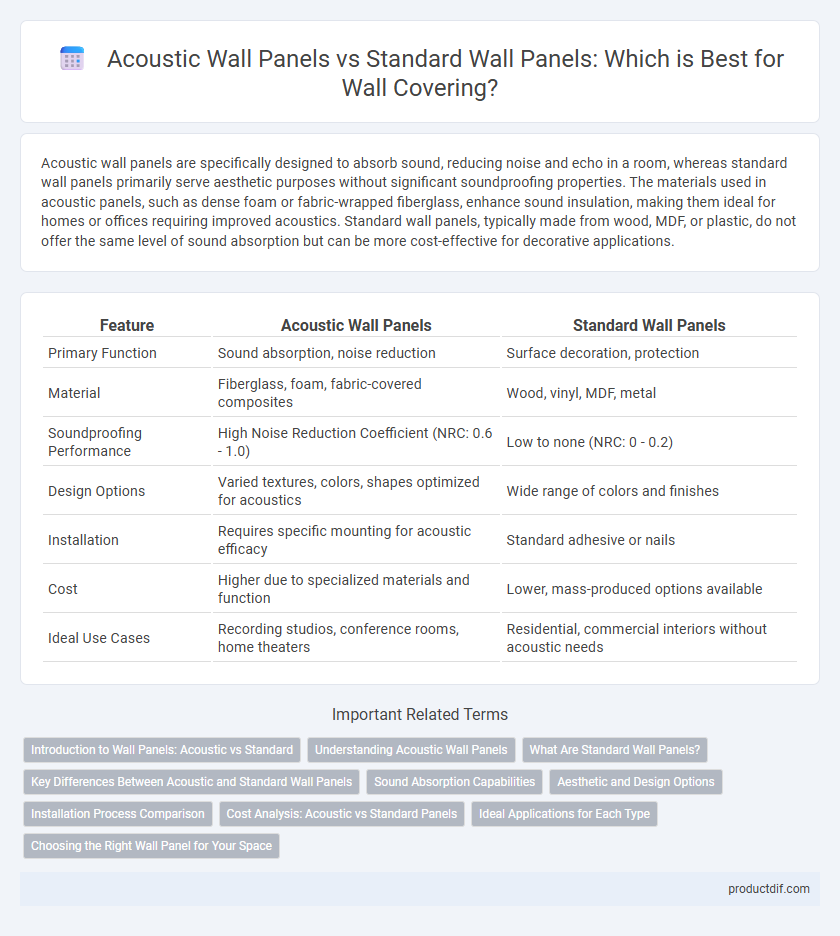Acoustic wall panels are specifically designed to absorb sound, reducing noise and echo in a room, whereas standard wall panels primarily serve aesthetic purposes without significant soundproofing properties. The materials used in acoustic panels, such as dense foam or fabric-wrapped fiberglass, enhance sound insulation, making them ideal for homes or offices requiring improved acoustics. Standard wall panels, typically made from wood, MDF, or plastic, do not offer the same level of sound absorption but can be more cost-effective for decorative applications.
Table of Comparison
| Feature | Acoustic Wall Panels | Standard Wall Panels |
|---|---|---|
| Primary Function | Sound absorption, noise reduction | Surface decoration, protection |
| Material | Fiberglass, foam, fabric-covered composites | Wood, vinyl, MDF, metal |
| Soundproofing Performance | High Noise Reduction Coefficient (NRC: 0.6 - 1.0) | Low to none (NRC: 0 - 0.2) |
| Design Options | Varied textures, colors, shapes optimized for acoustics | Wide range of colors and finishes |
| Installation | Requires specific mounting for acoustic efficacy | Standard adhesive or nails |
| Cost | Higher due to specialized materials and function | Lower, mass-produced options available |
| Ideal Use Cases | Recording studios, conference rooms, home theaters | Residential, commercial interiors without acoustic needs |
Introduction to Wall Panels: Acoustic vs Standard
Acoustic wall panels are specifically designed to absorb sound waves, reducing noise levels and improving room acoustics, making them ideal for environments like recording studios, offices, and home theaters. Standard wall panels primarily serve a decorative or protective function, offering aesthetic appeal and surface protection without significantly affecting sound quality. Choosing between acoustic and standard wall panels depends on whether noise control or visual enhancement is the primary objective.
Understanding Acoustic Wall Panels
Acoustic wall panels are specially designed to absorb sound waves, reducing noise and improving room acoustics, unlike standard wall panels that primarily serve decorative or protective functions. Made from materials such as foam, fabric, or fiberglass, acoustic panels help minimize echo and background noise, enhancing speech clarity in spaces like offices, studios, and theaters. Their installation contributes to better sound quality and noise control, making them essential for environments requiring optimal acoustic performance.
What Are Standard Wall Panels?
Standard wall panels are flat, rigid materials typically made from drywall, plywood, or MDF, designed to cover and protect interior walls while providing a smooth surface for paint or wallpaper. Unlike acoustic wall panels, they lack sound-absorbing properties and primarily serve aesthetic and structural purposes in residential and commercial spaces. Their affordability and ease of installation make them a common choice for basic interior wall finishing.
Key Differences Between Acoustic and Standard Wall Panels
Acoustic wall panels are engineered with sound-absorbing materials such as fiberglass, foam, or polyester fibers, designed to reduce echo and improve room acoustics, whereas standard wall panels prioritize aesthetics and durability without specific sound-control properties. Acoustic panels often feature perforated surfaces or fabric coverings that enhance sound diffusion, contrasting with the solid surfaces of standard panels. The key differences also lie in their installation purpose: acoustic panels are essential in environments requiring noise management like recording studios, offices, and theaters, while standard panels serve primarily decorative or protective functions in residential or commercial spaces.
Sound Absorption Capabilities
Acoustic wall panels are specifically engineered with sound-absorbing materials such as fiberglass or foam to reduce echo and improve room acoustics, achieving noise reduction coefficients (NRC) of up to 0.95. Standard wall panels primarily serve decorative or protective purposes and typically have minimal sound absorption properties with NRC ratings below 0.10. The enhanced sound absorption capabilities of acoustic panels make them essential for environments requiring noise control, such as recording studios, offices, and home theaters.
Aesthetic and Design Options
Acoustic wall panels offer a diverse range of textures, colors, and shapes, enabling enhanced aesthetic integration with modern interior designs compared to standard wall panels, which often come in limited finishes and flat surfaces. Their ability to be customized with fabric covers and patterns provides designers flexibility to create visually appealing and functional spaces without compromising sound quality. This fusion of design versatility and acoustic effectiveness makes acoustic panels ideal for stylish environments like offices, home theaters, and hospitality settings.
Installation Process Comparison
Acoustic wall panels typically require more precise installation techniques, including additional adhesive materials or mounting hardware designed to maintain soundproofing efficacy. Standard wall panels generally involve simpler installation procedures, often using nails or screws without the need for sound-dampening considerations. Proper alignment and securing of acoustic panels are critical to ensure optimal absorption and reduce noise transmission effectively.
Cost Analysis: Acoustic vs Standard Panels
Acoustic wall panels typically have a higher initial cost compared to standard wall panels due to specialized materials like foam, fiberglass, or mineral wool designed for sound absorption. Standard wall panels are generally less expensive but lack the noise-reducing properties of acoustic panels, making them less effective in environments where sound control is critical. Over time, acoustic panels can offer cost savings by reducing the need for additional soundproofing measures and improving overall acoustic comfort in commercial and residential settings.
Ideal Applications for Each Type
Acoustic wall panels are ideal for spaces requiring sound absorption such as recording studios, home theaters, conference rooms, and open office environments where noise reduction enhances productivity and clarity. Standard wall panels suit decorative purposes in residential and commercial interiors where aesthetics and wall protection are priorities without the need for advanced sound control. Selecting the appropriate wall covering depends on balancing acoustic performance with design goals tailored to the specific use of the space.
Choosing the Right Wall Panel for Your Space
Acoustic wall panels absorb sound waves to reduce noise and improve room acoustics, making them ideal for offices, studios, or home theaters. Standard wall panels primarily serve decorative or protective purposes without significant soundproofing properties. Selecting the right wall panel depends on your need for sound control, room function, and desired aesthetic impact.
Acoustic wall panels vs Standard wall panels Infographic

 productdif.com
productdif.com